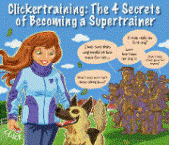Good Dog Training Advice
Get Fast & Simple Dog Training Tips to
Turn a Difficult Dog Into an Obedient Pet!
How to Deal with Multiple Dogs in One House
If you thought having one dog was tough, try adding a second or third and trying to keep control of them all at once. It can be trying and in many cases it can lead to battles between those dogs for dominance. They may not like each other at first, but if you're careful, you should be able to control them all with limited effort. The key is to hold control of your household and not let any one of the dogs claim it for themselves. Establishing Alpha Dominance Immediately, you need to assert your control over the household. Alpha leadership starts with body language, and showing a calm assertive outer shell that they will have no choice but to listen to. Your goal here needs to be to show them that you cannot be manipulated or circumvented. Don't yell or punish your dogs, but correct their behaviour when necessary. And while it may seem intangible, the easiest way to control your home is to believe that you are in charge. You need to be consistent with every command and own the space around you. Something as simple as "owning your space" will have a profound impact on a dog, who gets 95% of his cues from your body language, and not what you're saying. More importantly, when you have multiple dogs, they will want to compete with each other for dominance. If you've already asserted that dominance, what do they have to compete for? Dogs with a clear pack leader will become best chums seemingly overnight. Handling Problems Of course, if there are particular problems that your dogs have with each other, you do have options. Ideally, you being in charge with the alpha position should way lay most of the issues they are having, but it will not always. Here are some specific tips. Aggression - Basic dog aggression towards other dogs like nipping or growling can almost always be handled with alpha positioning of the owner. If you're bringing in an outside dog that doesn't have a clear position in the house, take them both for a walk first so they can acclimate on the leash. Many times, having this time on the leash will allow them to come to terms with each other neutral ground, outside the house. This is important for a dog that feels an outside dog is intruding on their space. Food Aggression - With dog food aggression, you have to be very careful. Alpha leadership doesn't always have the full effect you would like here. So, instead of posturing, separate the dogs and try to eliminate the aggression separately. Only then should you reintroduce them to each other. Barking - Dogs can get each other barking like nothing else and once they're barking together, it can be nearly impossible to control them. However, by separating them and ensuring they have nothing to be bored or anxious about, reducing their desire to bark, you can hopefully calm them all. Walking - If your dogs have issues walking together on a leash, make sure you're in control of the leashes. You may need to retrain them both separately, ensuring they both walk with or behind you, are lax on the leash and don't lash out at anything. Many times, leash issues derive from the desire of one dog to be dominant and ahead of the other. If you're in front, they have nothing to fight over. Ultimately, dogs that have issues with each other can be handled in tandem by you taking control of the household. If they do not come to terms with the new living arrangements, you may need to consider separating them or contacting an expert who can help them settle into their new roles.
| |
|


Discover the Secrets to Training Your Dog Or Puppy. Huge BONUSES for a limited time only!
Click here now...
|
http://GoodDogTrainingAdvice.com






